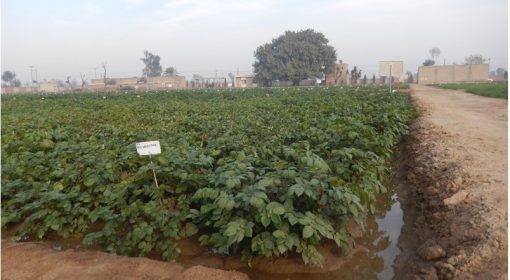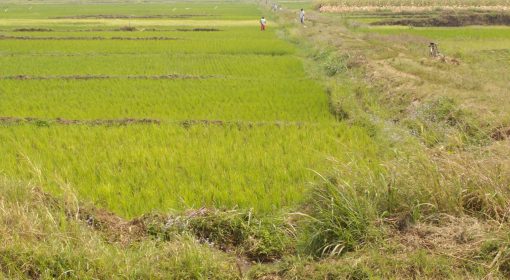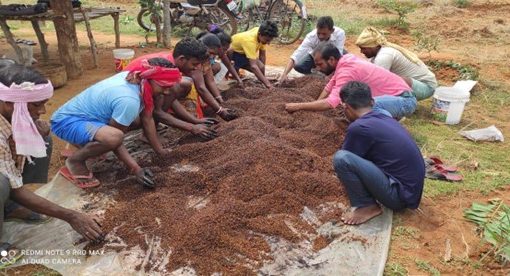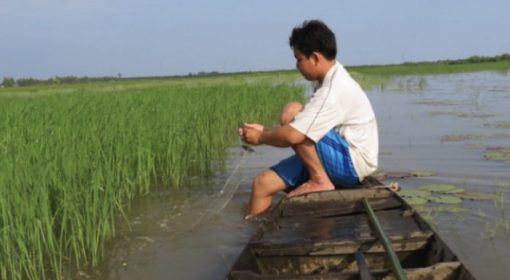Posted by Cecilia Borgia
September 20, 2013


Being a farmer in Mauritania is not easy. Soil degradation, destructive floods, devastating cricket invasions, and crop damages by rodents and birds…these are just some of the challenges Mauritanian farmers have to face on a daily basis.
The desert occupies more than 80% of the country. And rainfall is very low. So farming is concentrated almost entirely to the Senegal River Valley, at the southern border with Senegal.
Irrigation was introduced here in the 1960-1970s to guarantee food self-reliance after a long series of droughts. With irrigation came along exclusive focus on rice, until then virtually unknown to the area. Today, rice systems co-exist with a variety of traditional flood-recession and rainfed farming systems. But it is the irrigated rice that provides year-round food supply.
Yet since its introduction, irrigation has never lived up to expectations: less than 40 % of the area is used with average rice yields ranging from 3-4 t/ha. As consequence of this poor performance, Mauritania continues to rely heavily on food imports and aid. Together these make up 72 % of cereal and 48 % of rice consumption.A frequent narrative is that the collective
failure is at the root of the system: low profitability and performance of collective rice irrigation systems are due to farmers’ inadequate practices and the incapacity of farmer cooperatives to efficiently manage irrigation schemes.
But is this so? The picture I would like to convey is different, and more nuanced.
To start with, research revealed that irrigation, when combined with traditional farming systems (both rainfed and flood-recession farming) has effectively reduced food insecurity and increased family income. Secondly, low average yields conceal a large and bewildering variability between plots. Alongside failed fields, there are individual plots with yields upto 9 t/ha -close to the max – and this suggests a lot more is possible in Mauritania than what is common. The photo on the right (below) is an example. On the left is a poorly watered plot where yields do not even reach 2 t/ha. On the right is a well maintained plot with yields in excess of 7 t/ ha.

Management and performance of collective rice producing systems are also extremely diverse. Several farmer cooperatives are well organized. With arrangements for equitable and reliable water distribution, they ensure the smooth functioning of irrigation scheme. In such schemes, average yields of 5 t/ha are common. Again, two photos best illustrate this (see below). On the left, a poorly maintained irrigation pump poses serious constraints to reliable water delivery. On the right, the contrary holds true.

Much of the variability in rice productivity both across and within schemes has to do with the state of irrigation infrastructure and water management. At the heart of this is one major but often forgotten factor: inadequate drainage and waterlogging. These are prime variables affecting productivity in large-scale rice systems. The figure below shows a large area of 10 ha which gets recurrently inundated and thus cannot be cultivated. This results in a significant loss for farmers whose average irrigated plot is 0.7 ha. This problem can be reversed with some laser-levelling work and by rehabilitating the drainage network. So far, drainage has received far less attention globally than irrigation, despite evidence that controlling salinity and waterlogging has multiple benefits, including reduction of land degradation and increase in yields.

But there is more to say. While rice productivity in Mauritania is highly variable in general and low on average, the variability, rather than a result of farmers’ lack of ‘capacity’, is a reflection of the heterogeneity in individual and collective farming and livelihoods. Farmers’ objectives do not necessarily align with those pursued by food security planners, who focus on maximizing yields. The social role of possessing a rice plot in an irrigation scheme is at times more important than making the most of it in term of yields. It helps secure access to land, increase social status, and provides a resource that families can tap into whenever they manage to gather enough economic and human capital to invest. Due to the harsh competition from imported rice, land users often prefer to minimize production costs and risks rather than increasing yields and revenues.
To reduce risks, farmers cultivate on different irrigation schemes and engage more or less resources in one plot or the other. They might also cultivate occasionally, sub-renting the plot to other farmers in the meantime. Finally, the contribution of migration remittances is very important in sustaining ‘subsistence’ yields. Maximizing returns on investment and labour is one of the several reasons why farmers still turn to flood-recession and rainfed farming.
So which way to go? Crop diversification in existing irrigation schemes is an important option. If stimulated properly, it could help achieve food security and provide a more varied and nutritional diet. It could also help introduce locally accepted crops which suit better the lighter soils where rice is grown today at low water productivity levels. The strategy would also help enhance profitability and economic viability of irrigation schemes. But to get there, the design of rice schemes will have to be adjusted in a way that not all fields are flooded from rice cultivation. Also, irrigation delivery scheduling in non-rice plots should be independent of paddy. This implies that water should be supplied to these plots through separate pumps and channels.
Another route is to pay more attention to crops grown with traditional flood-recession and rainfed farming. Policies and practice have to support these equally important farming systems that have an equally high potential – often through simple measures and better varieties. It is the time to discover these rain and flood-based systems rather than continue dragging the dead horse of ‘modern’ irrigated rice cultivation, as has been done over the last forty years.



{jcomments on}



